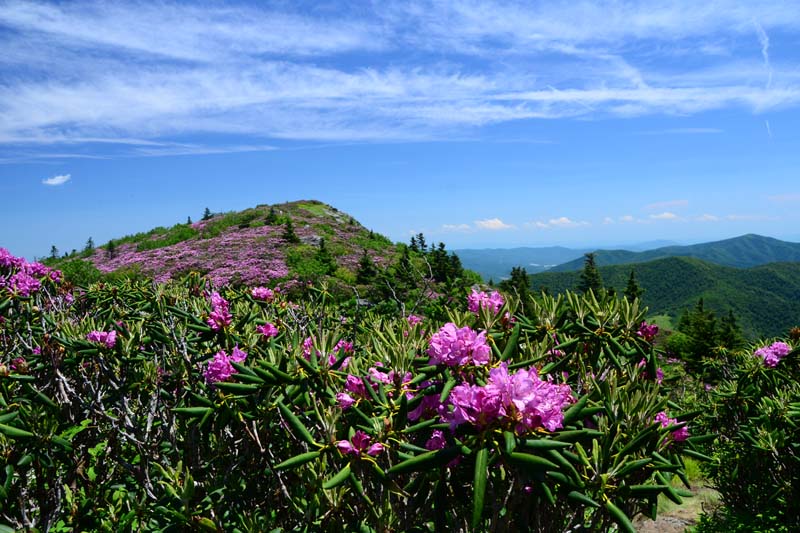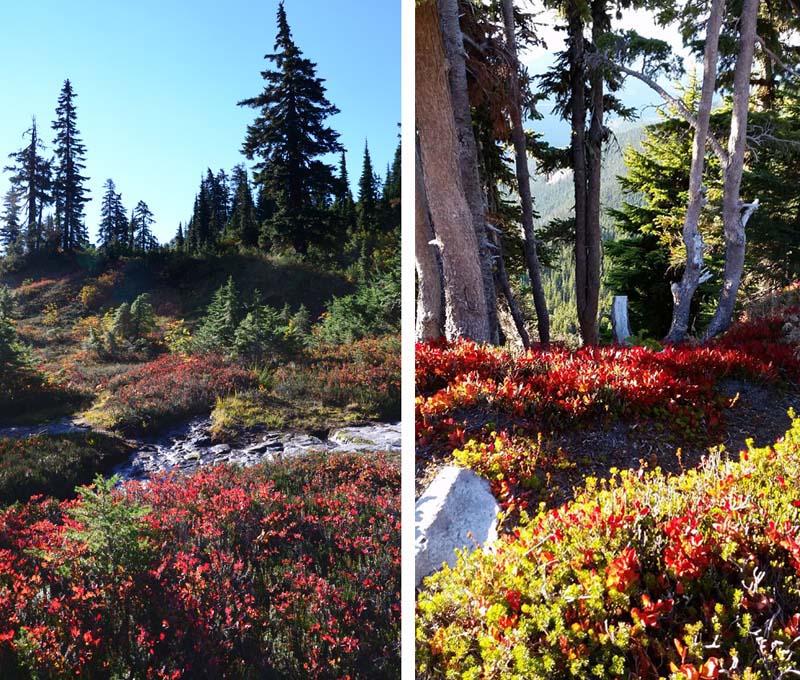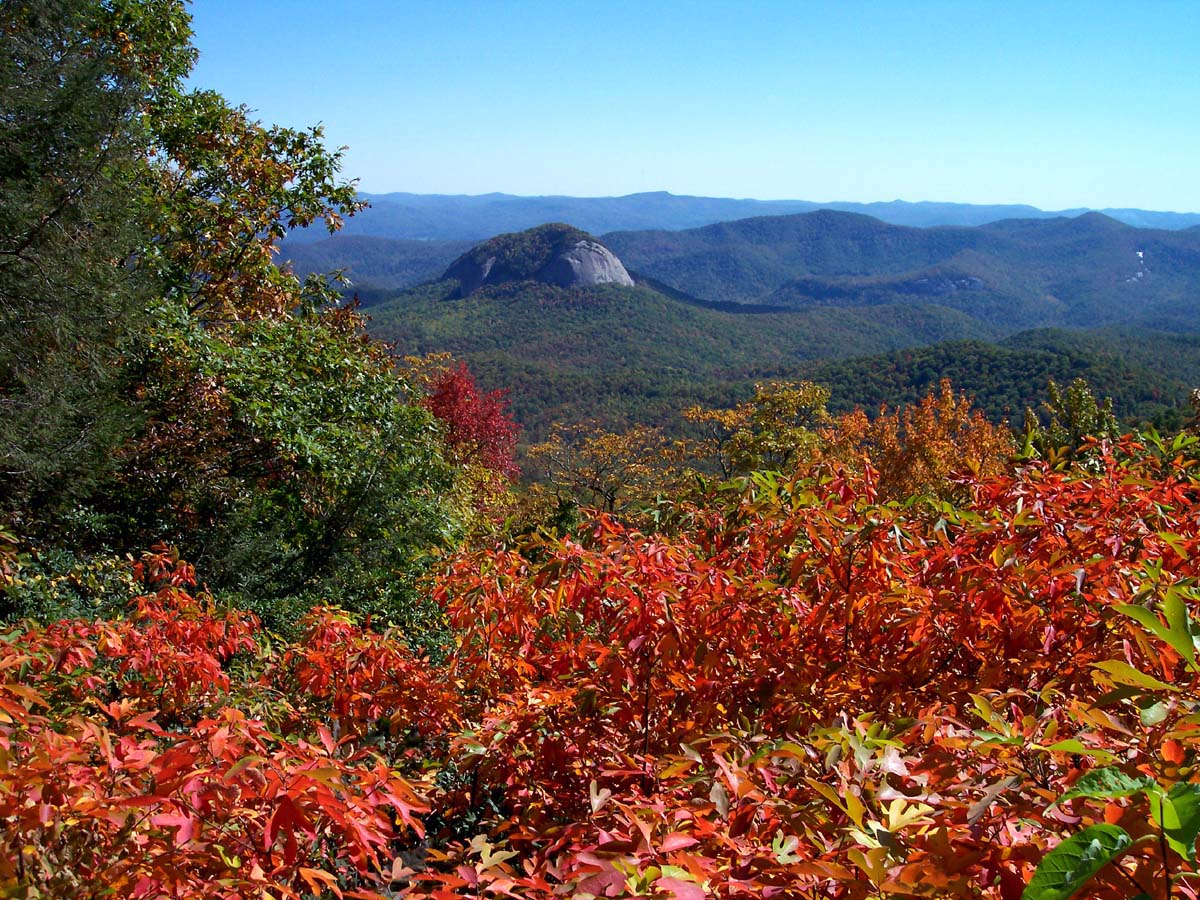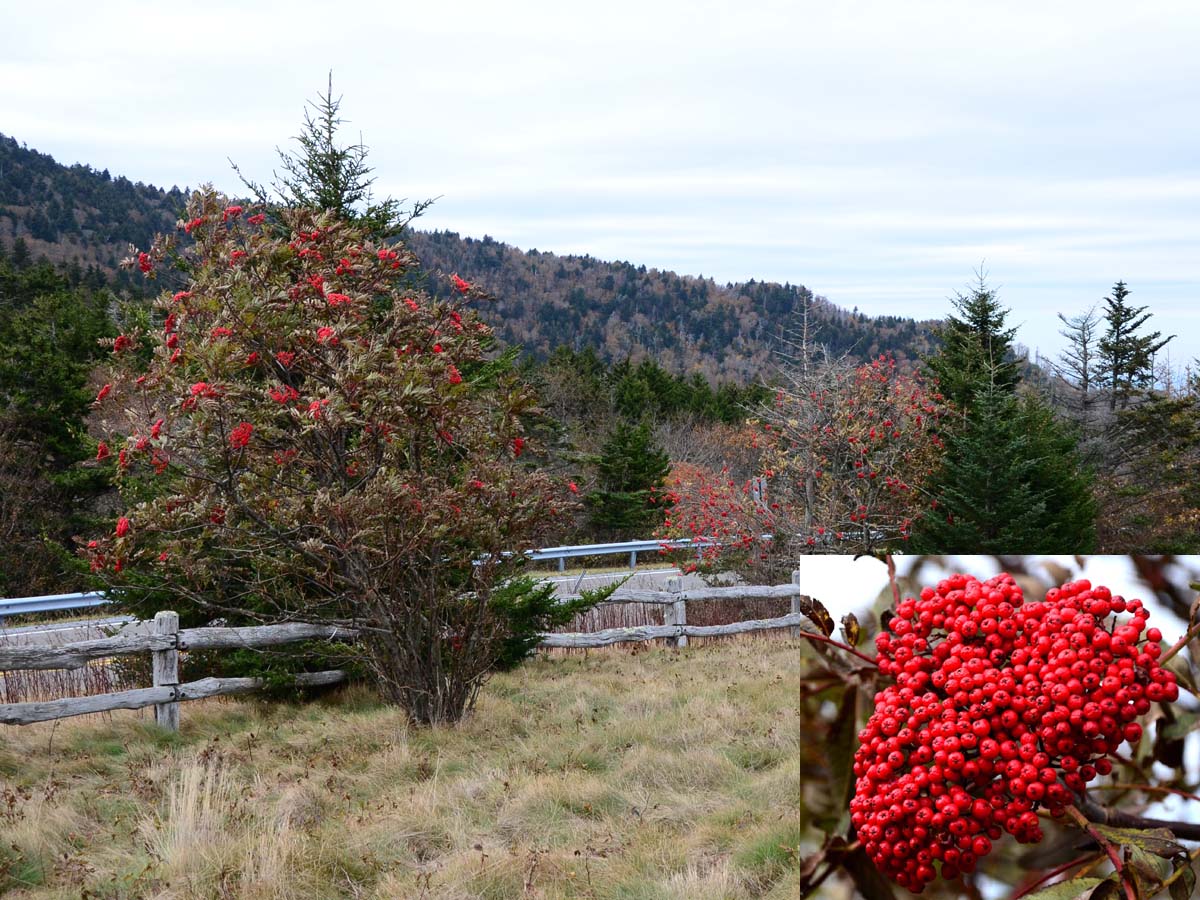

|
I think I have always been infatuated by mountains. I grew up on a wooded lot in the suburbs of
Washington, D.C., and the only time I could see the sky was when I walked into the center of the
backyard and looked straight up through the tree canopy. My garden vistas were short and stopped
at the woods edge. I think that has made me more appreciative of grand views. I love to watch the
sky and see the ever-changing randomness of clouds. When I stand on a mountaintop and survey the
distant scenery, I am in awe.
Our eastern mountains in the Southern Appalachians are incredibly beautiful and so rich, botanically. There are wonderful flowering trees and shrubs in spring, cool shaded glades in summer, but those deciduous forests put on a brilliant show when autumn arrives. The mountainsides can become a patchwork of autumn hues with scattered evergreen trees and shrubs for contrast. Roan Mountain on the border of North Carolina and Tennessee is certainly a favorite spot for me. The Appalachian Trail winds along the crest at elevations between 5000 to 6000 ft through open meadows, or balds, with 360-degree views of the mountains in all directions. It is breathtaking. Those who have hiked the entire 2000-mile Appalachian Trail often say that this stretch through the Roan Highlands is the most beautiful of all. "Through Hikers," the people who try to traverse the entire trail in one year, surely they miss the big show. They are miles away in mid to late June when the trail on Roan is flanked by orange, red, and yellow flame azaleas, Rhododendron calendulaceum, and masses of purple rhododendrons, R. catawbiense, and meadows filled with wildflowers. It is incredible! In autumn, there is another show when the foliage of the native azaleas turn rich burgundy, the grassy meadows change from green to gold, and the native blueberry species (Vaccinium) that went unnoticed earlier in the season are the show stoppers as their leaves turn brilliant red. Some of the plants may still have a few fruits the birds and animals missed. It is truly magical. The full 469-mile Blue Ridge Parkway is another national treasure. There are many overlooks with scenic views, short hikes to points of interest including waterfalls, and flowers all along the road. Different sections peak at different times of the year depending upon latitude and elevation but it is always beautiful. I have many favorite spots. The stretch south of Asheville all the way to the Great Smoky Mountains National Park is exceptionally scenic and has some of the most dramatic floral displays of flame azaleas, rhododendrons, mountain laurel, and wildflowers. The stretch near Mount Pisgah is one of the best places to see the rare pink native azalea, R. vaseyi. Its foliage turns red in autumn, too. The Smokies are fantastic, but so are other prime locations like Mount Mitchell, Grandfather Mountain, the Linville Gorge, and a relatively new road, the Cherohala Skyway. The Skyway runs through the National Forest south of the Smokies from North Carolina into Tennessee. We have found some exceptional flame azalea forms on Hooper Bald but the area has some of the best fall color as well. Autumn color usually peaks at the upper elevations in the Southern Appalachians in late September to early October. I must admit that I have never seen the famous fall foliage display in New England although I do hope to get there one day. I understand it peaks about the same time as our southern mountains so it is really hard to get away. Note: Special Thanks to Linda Derkach and Mike Stewart who provided some images used in this piece. All other photos were taken by the author. |

Vaccinium and native azalea foliage brighten the Appalachian Trail on Roan Mountain 
the Blue Ridge Parkway in North Carolina |

Brilliant fall color along the Cherohala Skyway in North Carolina |

Autumn Vista along the Cherohala Skyway |

Flame Azaleas along the Appalachian Trail on Roan Mountain in June |

Flame Azalea Foliage on Roan Mountain in October |

Patch of Vaccinium in fall color on Roan Mountain |

R. catawbiense turns many of the peaks on Roan to purple in June |

Vaccinium, evergreens, and bleached tree snags frame Mount Rainier 
Sorbus plants complement the vista of Mount Shuksan at Picture Lake |
The western mountains, especially the many volcanic peaks in the rugged Cascade Range, are truly
spectacular. The range begins in British Columbia and extends south through Washington and Oregon
to Northern California. It has non-volcanic ranges as well as prominent volcanic peaks like Mount
Rainier at 14,411 ft. (4392 meters) Our eastern mountains were supposed to be as high as the
Himalayas 250 million years ago but they have eroded over time to the forested peaks we see
today, the highest of which is Mount Mitchell at 6,684 ft. (2037 meters)
There are so many spectacular sights including Mount Rainier, Mount Hood, and Mount Baker which are part of the Cascade Range but there are other phenomenal mountains like the Olympics to the west on the Washington Coast and the Sierras to the south including the incomparable Yosemite National Park. Whenever I attend an ARS meeting on the West Coast, I always try to add some extra days to do some touring on my own. In April and May, many of the mountain routes are still blocked by snow but when I was in college, I had a chance to tour in early summer and saw the phenomenal wildflower display. Since I retired, I have been meaning to get back but at that time I am usually chasing the native azalea and rhododendron bloom in the east. I have been there in early fall, and that is when the tall peaks get refreshed with new snow as the fall foliage turns color. Although there are fewer deciduous trees, there are many deciduous shrubs including the Cascade blueberry, Vaccinium deliciosa, that turns brilliant red just as our species do in the east. There are some western maples, but at upper elevations, the foliage of R. albiflorum will turn a lovely shade of yellow. Another eye catcher is the Cascade Mountain Ash, Sorbus scopulina, with its yellow fall foliage and clusters of red berries. We have comparable eastern species, Sorbus americana, in the Southern Appalachians which has larger berry clusters but the fall foliage is not distinctive. One of my all-time favorite spots is the Mount Baker area in the North Cascades of Washington State. The perfect photo op is an adjacent peak, Mt. Shuksan, that can be perfectly reflected in Picture Lake on a still day. There is parking area at the end of the road where there are more views of Mt. Shuksan and Mt. Baker. I particularly enjoy the Artist Ridge Trail which is not difficult and provides awesome views. Since many of the wildflowers at that elevation may have been under snow packs all summer long, it is often possible to see a few spring wildflowers like lupines and heathers flowering as they grab a bit of warmth in late summer, just before the winter snows arrive again. Linda Derkach sent images of Mount Arrowsmith which is one of the highest mountains on Vancouver Island in British Columbia, Canada. Its elevation is 5968 ft. (1819 meters) At nearby Cameron Lake in October, the Cornus stolonifera plants along the shore turn red while the cottonwoods turn yellow. On a calm day, the reflections can be stunning. Meanwhile, the native Acer macrophyllum trees on the hillside among the evergreens begin turning butter yellow. |

Mount Shuksan in the North Cascades reflected in Picture Lake |

Red vaccinium and Mount Baker viewed from Artist's Ridge Trail |

photo D. Hyatt photo M. Stewart |

Lupine blooms along trail in September (right) |

Mount Arrowsmith on Vancouver Island in British Columbia photo L. Derkach |

Reflecions in Cameron Lake near Mt. Arrowsmith, BC Cornus stolonifera and cottonwoods photo L. Derkach |
|
This section has a few more images of the beautiful color in the mountains on both coasts.
In the east, there are so many trees with great fall color including Nyssa sylvatica, the
Tupelo or Black Gum Tree, and
Oxydendrum arboreum, the Sourwood or Lily of the Valley Tree. Sourwood honey is highly prized
for its floral quality.
The Sassafras tree, Sassafras albidum, is known for its aromatic bark and roots which
were the main ingredient of traditional root beer.
I have included some images images of the native azalea R. vaseyi in the spring as well as its beautiful fall foliage. We will have future newsletters that focus on the spring bloom later. There is also an image of the western deciduous rhododendron species, R. albiflorum, that only seems to grow at high elevations. The fall foliage pictures of that species were taken on the North Cascades Scenic Highway at Washington Pass. That is a beautiful drive. I have included a few images of other favorite western attractions. More on those at a later date, too
|

|

Vista of Looking Glass Rock |

Blueberry (Vaccinium) Fall Color (left) and Fruit (right) |

Eastern Mountain Ash (Sorbus) on Roan Mountain |
 Washington Pass Overlook and R. albiflorum
Washington Pass Overlook and R. albiflorum
|

R. vaseyi in bloom in early May |
 R. vaseyi fall color in early October
R. vaseyi fall color in early October
|

R. albiflorum: Flower (left) Fall Color (right) photo M. Stewart photo D. Hyatt |

R. vaseyi Flowers |

R. vaseyi Fall Foliage |

|

|

|

|